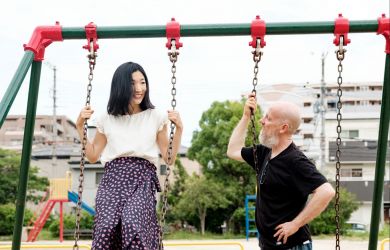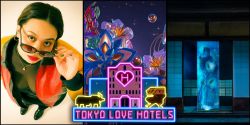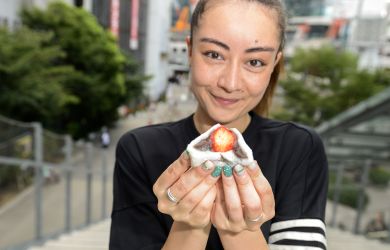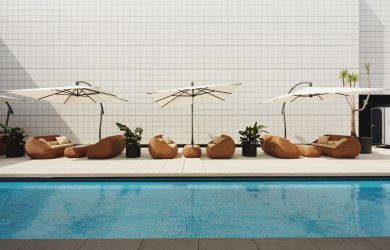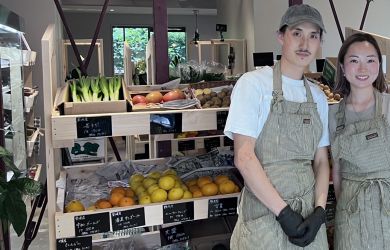
Akita-born artist Tomoko Konoike’s works are not rooted in art theory but are fundamentally human things. To her, humans are another one of Earth’s creatures and in a constant state of evolution and change. Konoike’s nihonga-style (Japanese-style) surreal paintings and large-scale installations are renowned in both Japan and abroad, and her latest exhibition will be at Tokyo’s newly-opened Artizon Museum from June 23 to Oct. 25.
Metropolis: You mentioned in a previous interview that the 2011 Tohoku earthquake and tsunami had an impact on your creative process and work itself. How is the coronavirus pandemic affecting your work now?
Tomoko Konoike: Unlike the Tohoku earthquake in 2011, where those affected received help from Japan and abroad, there is not such a clear “victim and helper” dynamic for this pandemic because it’s the entire world that’s experiencing this crisis. My way of life as an artist has remained the same, but the world and its society of rapid consumption is now slowly stopping. Even if the world was to go back to the beginning, we, as human beings, can no longer be the same anymore. Still, we, as animals, feel like new ideas will be born out of this situation on Earth.

M: Speaking of animals, your depiction of humans often mixes us with creatures or nature, displacing us from the civilized systems and cities we’ve become accustomed to in modern life. One of your recurring motifs is the reduction of the human body to child’s legs immersed in nature, or distorting it with the body of a wolf. Why are you attracted to the natural world in your art?
TK: Personification has been a major method of animal motifs in art up until now, but my art does the opposite, aiming to be animalization of human beings — or post-personification — because I intend to shift the perspective from a human-centered one into the one where human beings are just another kind of animal on Earth. As global warming and the coronavirus pandemic show us, the way of human life is no longer sustainable and we have to confront this so as to think about the future of the world. I think humans need to put their ideologies aside and think differently, but our ways are deeply ingrained in us and reinforced by the societies we live in. As an alternative, I believe it’s possible for us to look to other things ― such as animals. I think my work suggests liberation of human thoughts, freeing ourselves from our conventional ways of human life.
M: If your work suggests liberation, are you interested in seeing how people react to your art or are liberated through it?
TK: My aim is not to make interactive art or to communicate with the audience, but it is to awaken the audience’s various wild elements that are ingrained within us. I’d like to create solid things people can still feel without using their vision. Most art at museums is visual art; rather than being afraid of things when you have no vision, I want us to experience things by using our bodies’ other senses ― like touch. My works are fundamental human things instead of sophisticated art theory or anything. I call it “primordial violence.”
It would be such an honor if my art triggers another feeling, an awakening of the viewer’s deepest, most-primitive inner emotions such as desire, fear or terror. I sneak and evoke these primitive elements into the civilized places of my exhibitions by using animals. I’m very curious about how people experience my art and how that may impact their lives. For me, it’s the individual’s act of interpretation that’s important, not whether someone likes or dislikes my art.
View this post on Instagram
M: Your work uses a lot of animal pelts. How do you feel about veganism and the use of animal products?
TK: First of all, all the animal pelts I’m using are legally collected, such as from pest control. It’s a human’s perspective to categorize animals as pests or as ones to protect, depending on the place or situation. This fact is also based on the fundamental human drive to survive and continue their life on Earth. I think this is another example of primordial violence.
Given that the term “vegan” has become more mainstream recently, it feels that veganism has recently come into fashion now. In my opinion, the term “vegan” is a human idea and was coined by those who care about the current global environment. But respecting and caring for Earth has always been a concern of humans, even before the word for veganism appeared in language.
Personification has been a major method of animal motifs in art up until now, but my art does the opposite, aiming to be animalization of human beings — or post-personification — because I intend to shift the perspective from a human-centered one into the one where human beings are just another kind of animal on Earth.
M: Spatially, your work is displayed in many ways, from art galleries to outdoor installations in the middle of nature. What draws you to the latter?
TK: Museums are white empty spaces but there’s no big blank canvas like that in the natural world. In nature, the art itself has to be tough enough to survive the elements and, if it wants to be seen by an audience, it has to compete with the chaos and colors of nature. In museums, everything is conveniently set, ready for both artist and audience, which blurs the true value of art. I’ve been creating outdoor installations my whole career because I feel artificial gallery spaces are too sheltered, but after the Tohoku [disaster] realized just how vulnerable our modern way of life is. Museum spaces are too convenient; there’s no challenge for the viewer to trek through nature to see the art, to go back to our roots. But it’s this journey into nature that’s important to me; after all, we are all creatures of nature. The art is just a medium for that journey.

M: You mention canvases, but your use of materials is so wide, animal pelts, unglazed clay, fabric, wood, mirrors…etc. I particularly love “Drop Curtain of Cowhide” (2015). How did you come to use such raw, primitive materials?
TK: Like I said, I think I was so used to working on white canvases or paper and one day, when the Tohoku earthquake happened, I realized I no longer enjoyed the process, even if it turned out to be a great work. When working with paper and canvases, my hands automatically knew what to do; it felt like being on a treadmill. I then found that animal pelts have so much potential: you can enjoy their tactility, draw on them, sew them together into a bigger skin and the shape is always irregular.
M: In terms of scope, you often play with the macro and micro, distorting our usual views of the world ― like how you captured a galaxy inside a moth’s wings in “Black Kite” (2019).
TK: It’s just like how the views of humans are constantly changing. Plus, humans nowadays are always trying to expand their territory around them, but they also love spending time in their room. Both are normal behaviors although they seem paradoxical; having multiple sides is not a strange thing.
“Black Kite” is a drawing on multiple cow hides sewn into one. This art hung for a year in the forest of Oshima Seishoen Sanatorium on Oshima Island, which is a sanatorium for Hansen’s disease. It faced a lot of wind and rain and insects and microbes ate away at the skin. This work’s body literally engaged in a dialogue with the Earth. It’s going to be at my exhibition, “FLIP,” at the Artizon Museum in Tokyo soon.
View this post on Instagram
M: “FLIP” is the first in a series of Jam Sessions at Artizon, in which artists select pieces from the Artizon Museum’s Ishibashi Foundation Collection to collaborate with. How was this experience for you?
TK: I visited a couple of times to see a tremendous amount of the collection but I couldn’t choose ones which were speaking to me enough to work with. Then, I came up with the idea to borrow someone else’s perspective, to see the classical works through their eyes and how they saw relationships between the Ishibashi collection and my contemporary art. So I asked the curator from Artizon and she thought my work connected a lot to her main genre of research, 19th century French art. This taught me that there’s so much left for artists to learn about their own work through the perspectives of others.
M: Your exhibition is going to be the first one of this Jam Session series at the newly opened Artizon Museum. What else can we expect from this series?
TK: The role of new museums is not always to showcase new artists. Their role is to update the old framework or value of museums to match today’s society. Museums originally emerged out of nationalistic consequence, to show off a nation’s wealth and property to its citizens’ the other countries. However, the world has changed a lot and the concept of a museum is now out of date. There must be ways that we, a new generation, can inherit and participate in this original concept of the museum, but adapt it to the modern society in which we live.
As an animal, each human being grasps the world with totally different perceptions. We see the world through our own umwelts. None are the same. No words are identical. No light is identical. If the arts prepare themselves for that and address it honestly, then in time, a new ecosystem, filled with the senses, for a small organism, will begin to function. Instead of substituting illusions for words, let us feel our way to the small things we encounter daily, play and quietly do our work.
Check Tomoki Konoike’s website or Instagram page to learn more about the artist.
Jam Session: The Ishibashi Foundation Collection x Tomoko Konoike: FLIP
Jun 23 – Oct 25
Tues – Sun 10am – 6pm
Due to the COVID-19 pandemic, museum capacity is limited.
Please book online in advance.
Artizon Museum
1-7-2 Kyobashi, Chuo-ku
artizon.museum
